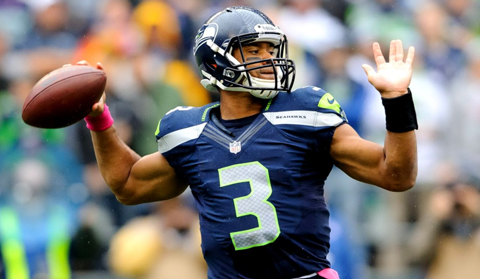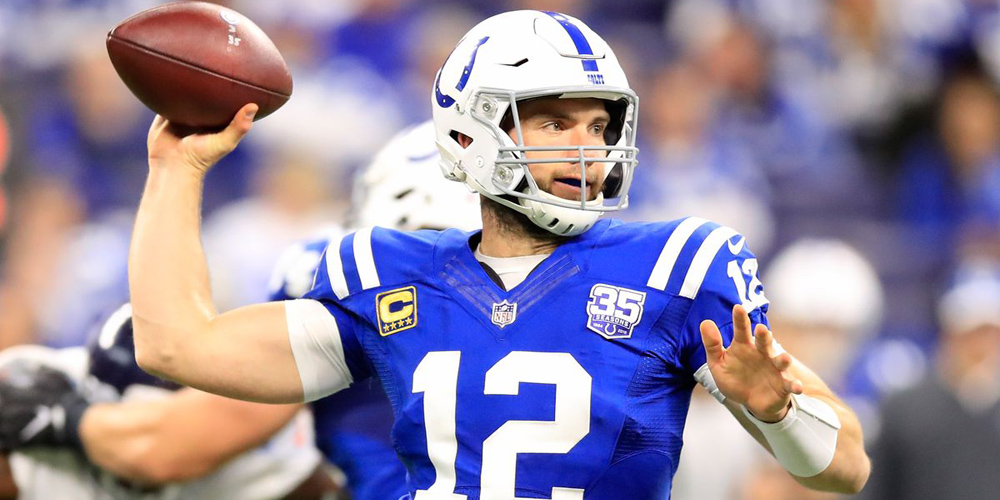Top Red Zone Quarterbacks from 2018
With all due apologies to frustrated defensive coordinator’s, in today’s high-octane era of football, the highest scoring teams tend to be the most successful. That is especially true in fantasy football where the ability to secure the best touchdown producers is usually a sure-fire way to make the playoffs or even, in some cases, outright win leagues.
Touchdowns themselves can be hard to predict from year-to-year, but the one position that carries the most consistency is at quarterback. A signal-caller that can consistently perform well in the red zone and produce solid touchdown passing numbers annually can be a hugely important asset in fantasy lineups, even for multiple years in a row.
The red zone is where the vast majority of touchdowns are produced, so knowing which quarterbacks were the most effective in that area of the field is an excellent tool to have the arsenal of the well-prepared fantasy footballer. Using the red zone passing numbers available from the Fantasy Data advanced efficiency metrics, here were the 20 most effective red-zone passers from 2018.
Quick Links
- Fantasy Player Projections
- Fantasy Football Rankings
- PPR Fantasy Rankings
- Advanced WR Metrics: The Predictive Ability of Air Yards
- Advanced QB Metrics: The Best and Worst Quarterbacks Under Pressure
- True Catch Rate: Which WR’s Have the Best Hands
players ranked by total red-zone attempts
Quarterbacks Ranked 11-20
| Player | TEAM | COM | ATT | COM% | YDS | TD | INT | COM | ATT | COM% | YDS | TD | INT |
| Kirk Cousins | MIN | 48 | 72 | 66.7 | 302 | 20 | 0 | 16 | 30 | 53.3 | 59 | 12 | 0 |
| Matthew Stafford | DET | 35 | 72 | 48.6 | 234 | 14 | 3 | 10 | 28 | 35.7 | 42 | 8 | 1 |
| Philip Rivers | LAC | 43 | 71 | 60.6 | 287 | 22 | 2 | 23 | 38 | 60.5 | 116 | 15 | 1 |
| Dak Prescott | DAL | 36 | 70 | 51.4 | 224 | 12 | 2 | 15 | 30 | 50.0 | 51 | 7 | 1 |
| Case Keenum | DEN | 36 | 69 | 52.2 | 242 | 11 | 4 | 17 | 35 | 48.6 | 70 | 8 | 2 |
| Mitchell Trubisky | CHI | 41 | 64 | 64.1 | 267 | 18 | 1 | 18 | 31 | 58.1 | 69 | 11 | 0 |
| Russell Wilson | SEA | 36 | 63 | 57.1 | 289 | 24 | 2 | 18 | 33 | 54.6 | 81 | 14 | 1 |
| Derek Carr | OAK | 39 | 63 | 61.9 | 215 | 14 | 2 | 24 | 41 | 58.5 | 77 | 11 | 1 |
| Carson Wentz | PHI | 34 | 58 | 58.6 | 229 | 18 | 1 | 16 | 24 | 66.7 | 55 | 11 | 1 |
| Baker Mayfield | CLE | 38 | 57 | 66.7 | 264 | 20 | 0 | 15 | 25 | 60.0 | 40 | 10 | 0 |
| Cam Newton | CAR | 39 | 57 | 68.4 | 269 | 19 | 2 | 18 | 27 | 66.7 | 71 | 12 | 0 |
Kirk Cousins (Minnesota Vikings) – No surprise to see perennially-underrated Minnesota QB Kirk Cousins perform well in the red-zone. Cousins consistently posts QB1 numbers and has one of the league’s top wide receiver duos to throw to. Cousins ranked fourth among all NFL quarterbacks with a 66.7% completion rate and threw 20 scores against zero interceptions. With a healthy Dalvin Cook in the backfield, the Vikings want to try to establish the run more in 2019, but Cousins should still contend for top-10 quarterback numbers, making him a terrific fantasy football sleeper.
Matthew Stafford (Detroit Lions) – Stafford had the same amount of red-zone pass attempts as Cousins (72) but was far less effective. Of course, not all of that was on Stafford, as no team had more drops than the Lions. Still, Stafford’s 48.6% RZ completion rate ranked 19th, and he threw the third-most interceptions (3) inside the opponent’s 20-yard line. Like their NFC North counterparts in Minnesota, the Vikings have a defensive-minded coach and want to become more run-oriented. While Stafford will probably not be as ineffective as he was one year ago, he’s not a good bet to be a prolific red-zone passer.
Philip Rivers (Los Angeles Chargers) – Only 13th in red-zone pass attempts, Rivers ranked 7th with 22 scores and was particularly effective inside the 10-yard line. In that area, Rivers ranked third with 116 yards and had a 15-to-1 TD-to-INT ratio. As long as Melvin Gordon is holding out, we could see the Chargers be even more reliant on Rivers, especially in the red zone.
Dak Prescott (Dallas Cowboys) – Prescott is a red-zone dual threat. In addition to ranking 14th in red-zone pass attempts, Prescott also rushed 19 times for 72 yards and chipped in six touchdowns on the ground, which ranked second among all NFL signal-callers. When RB Ezekiel Elliott is on the field, he’ll get the majority of the Cowboys’ touches as the offense nears the goal line. But with Elliott currently holding out in Cabo, we can project a boost in Prescott’s red-zone passing role moving forward– at least until Zeke returns.
Case Keenum (Denver Broncos) – A career journeyman, part of Keenum’s struggles have come in the red zone, where he performed poorly last year for Denver. Keenum’s 69 attempts ranked 15th, but he had the fewest touchdowns among any quarterback that threw more than 51 red zone attempts. He also tied Ben Roethlisberger for the most RZ interceptions (4), including two that occurred inside the 10. Those turnovers can kill a team and help explain why Keenum will have a hard time being a consistent NFL starter.

Derek Carr (Oakland Raiders) – Carr wasn’t nearly as bad as the general consensus thinks he was, but the Raiders weren’t competitive and didn’t look like the kind of squad that’s capable of a quick turnaround. That makes Carr a bit of a risk to be benched if he doesn’t show improvements in critical areas, like a very mediocre 3.41 yards per attempt figure in the red zone.
Carson Wentz (Philadelphia Eagles) – He only ranked 19th with 58 red zone passing attempts, but Wentz was less than one year removed from a shredded ACL and missed five games. If you extrapolate Wentz’s red zone numbers out to a 16-game pace, you get 333 yards and 26 touchdowns, which would have been the third-most in football. Now further removed from that knee injury and the Eagles only adding more offensive weapons, Wentz is a strong candidate for top-5 overall numbers in 2019. 4,200-plus yards and 35 touchdowns aren’t out of the realm of possibilities.
Baker Mayfield (Cleveland Browns) – Mayfield was one of only four regular NFL starters to not suffer a red zone interception in 2018, doubly impressive for a rookie signal-caller who didn’t even open the season as his team’s starter. Mayfield tied Kirk Cousins for fourth in the NFL with a 66.7% completion rate in the red zone and was top five in average yards per attempt. With red zone monster Odell Beckham Jr. now in town, Mayfield looks poised to be one of the most effective RZ passers in the NFL in his sophomore season.
Cam Newton (Carolina Panthers) – Only Drew Brees posted a better red zone completion rate than Cam Newton’s 68.4%. Newton also doubles as an excellent runner and produced another 54 rushing yards and four touchdowns in the red zone last year before missing the Panthers’ final two contests with a shoulder injury. He’s not always going to post the most prolific passing numbers in Carolina’s offense, but Newton has a fantastic duo of young wideouts and has been an excellent TD producer. He’s accounted for 25-plus scores in six of his eight seasons.
Continue Reading… Advanced QB Metrics: Top Red Zone Quarterbacks
Become a member at FantasyData and read this article in full. You’ll also get access to a ton of fantasy football metrics that will help you dominate your fantasy draft and help you throughout the NFL season. Click Here to Learn More
Top-10 Red Zone Passers
| Player | TEAM | COM | ATT | COM% | YDS | TD | INT | COM | ATT | COM% | YDS | TD | INT |
| Patrick Mahomes | KC | 66 | 104 | 63.5 | 488 | 35 | 1 | 27 | 47 | 57.5 | 103 | 20 | 0 |
| Jared Goff | LAR | 59 | 101 | 58.4 | 421 | 23 | 2 | 25 | 50 | 50.0 | 118 | 16 | 2 |
| Andrew Luck | IND | 67 | 100 | 67.0 | 470 | 33 | 1 | 30 | 43 | 69.8 | 128 | 19 | 0 |
| Ben Roethlisberger | PIT | 53 | 94 | 56.4 | 354 | 21 | 4 | 23 | 38 | 60.5 | 84 | 14 | 2 |
| Drew Brees | NOR | 67 | 93 | 72.0 | 396 | 22 | 0 | 31 | 43 | 72.1 | 110 | 16 | 0 |
| Tom Brady | NE | 49 | 88 | 55.7 | 376 | 18 | 1 | 16 | 40 | 40.0 | 80 | 12 | 0 |
| Eli Manning | NYG | 41 | 86 | 47.7 | 270 | 19 | 2 | 17 | 36 | 47.2 | 69 | 13 | 1 |
| Deshaun Watson | HOU | 43 | 79 | 54.4 | 332 | 20 | 0 | 19 | 42 | 45.2 | 95 | 12 | 0 |
| Matt Ryan | ATL | 48 | 77 | 62.3 | 389 | 23 | 1 | 21 | 41 | 51.2 | 103 | 15 | 0 |
| Aaron Rodgers | GB | 31 | 73 | 42.5 | 240 | 16 | 1 | 10 | 25 | 40.0 | 50 | 9 | 1 |
Patrick Mahomes (Kansas City Chiefs) – Only one quarterback had more than 35 total touchdown tosses last season, which was Patrick Mahomes’s total just in the red zone. Only Peyton Manning, who had 40 back in 2013, has ever thrown more red-zone touchdowns in a single season. Mahomes also led the league with 488 passing yards inside the 20. It’s hard to envision Mahomes matching those phenomenal numbers again, but he looks poised to be one of the most effective potential touchdown producers for years to come.
Jared Goff (Los Angeles Rams) – Thanks to Sean McVay’s innovative play-calling and aggressive nature, Jared Goff ranked second in the league with 101 red zone attempts but that number could possibly go up in 2019. While Todd Gurley is a bit of a boom-or-bust option, it’s all but assured that McVay will cut back on Gurley’s workload in order to keep his ailing knee as healthy as possible. That could mean more reliance on Goff’s right arm, which would lead to even better red zone numbers for a prolific Rams’ offense that projects to be one of the highest-scoring units in the NFL once again.

Ben Roethlisberger (Pittsburgh Steelers) – Big Ben had his finest season as an overall passer, which included the fourth-most pass (94) attempts in the red zone. Sans Le’Veon Bell in the lineup all season, it wasn’t really a shock to see the Steelers have to rely so much on the pass. But while Roethlisberger got plenty of opportunities, he wasn’t particularly effective. Inside the red zone, he ranked 14th in completion rate, 15th in yards per attempt, and tied Case Keenum with a league-worst four interceptions.
Drew Brees (New Orleans Saints) – The uber-accurate Brees unsurprisingly led the league with a 72% red zone completion rate, which was actually slightly higher (72.1%) inside-the-10. Brees tossed 22 red zone scores against zero picks. After throwing just 17 RZ touchdowns in 2017, Brees rebounded back up to a respectable 22 last year, which ranked sixth. WR Michael Thomas (3rd) and RB Alvin Kamara (5th) both ranked inside the top-5 in the league in red-zone targets. As long as that duo remains healthy, Brees should remain one of the best red-zone passers in the game.
Tom Brady (New England Patriots) – Although he’s probably no longer capable of producing the prolific numbers he used to put up, Brady is still a solid bet to post reliable touchdown numbers and limit painful red-zone turnovers. The addition of RB Sony Michel will take a few scoring opportunities away, but there are no alarming signs of decline that Brady, who will be 42 on opening day, is due to suffer a sudden decline. In fact, Brady looks like a good bet for another season of 30 total touchdowns and is a solid bargain at his deflated ADP.
Eli Manning (New York Giants) – Like most of Manning’s other usable fantasy stats from last season, Manning’s red zone prowess was mostly a product of a lousy team continuing to throw the ball in futile attempts to come from behind during one of the team’s 11 losses. Manning ranked seventh with 86 red zone attempts but was 20th with a lowly 47.7 completion percentage, 12th in yards, 12th in touchdowns, and last among the charted players with an atrocious 3.14 yards per attempt average.
Deshaun Watson (Houston Texans) – When you consider that Deshaun Watson faced pressure on a league-worst 25.5% of his dropbacks and was sacked a league-high 62 times, his performance under pressure and in the red zone was quite remarkable. Especially when you also take into account how injury-riddled Houston’s receiving corps was. In the red zone, Watson ranked eighth with 332 passing yards and had an impressive 20-to-0 TD-to-INT ratio. Watson also ran for additional 100 yards and led the Texans with five red-zone TD runs. He’s a top-5 signal-caller in any and every format.
Matt Ryan (Atlanta Falcons) – The Falcons weren’t as good on the ground last year due to RB Devonta Freeman missing essentially the whole season. That led to Atlanta having to rely on Ryan more and the veteran signal-caller responded with a solid 62.3% completion rate and 23 scores. Those were both huge improvements for Ryan, who struggled with Steve Sarkisian’s inferior play-calling. In 2017, Ryan only completed 48% of his red-zone throws and tossed 15 TDs. Ryan has a history of alternating up and down every other year, so expect a least a slight decline off of his QB3 finish in 2018.
Aaron Rodgers (Green Bay Packers) – When you look at the body of work for Aaron Rodgers versus his performance last season, 2018 sticks out. I already analyzed how poorly Rodgers performed under pressure last season, but he also had issues in the red zone. These aren’t the only reasons Rodgers produced the lowest TD pass numbers of his career in a 16-game season, but they played an integral part. Rodgers ranked dead last of these charted players with a 42.5% red zone completion rate and only threw for 16 TDs–the same number Andy Dalton put up in 11 games. With a new staff in town, there’s nowhere to go but up for Rodgers. R-E-L-A-X.

